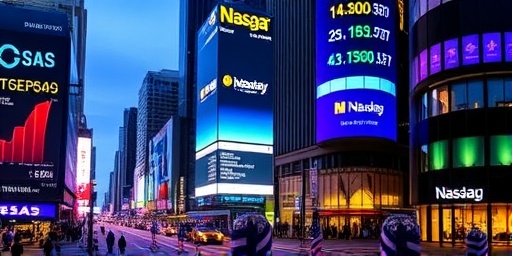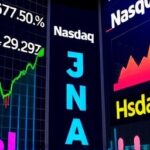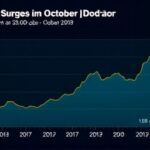In a robust kickoff to November, the S&P 500 and Nasdaq composite indices surged to multi-month highs, propelled by escalating corporate commitments to artificial intelligence technologies. Investors, buoyed by reports of massive AI spending from tech behemoths, poured capital into the stock market, with Amazon’s shares catapulting to an all-time peak amid optimism over its cloud computing dominance.
The S&P 500 climbed 1.2% to close at 5,890 points, marking its strongest single-day gain since mid-October, while the Nasdaq jumped 1.8% to 18,650, reflecting heightened enthusiasm for AI-driven growth stocks. This momentum comes on the heels of a volatile October, where geopolitical tensions and inflation concerns had tempered gains, but fresh data on AI investments has shifted the narrative toward expansion and innovation.
Market analysts attribute the rally to a confluence of factors, including quarterly earnings previews that highlight surging demand for AI infrastructure. ‘The stock market is pricing in a new era of productivity gains from AI,’ said Sarah Thompson, chief strategist at Vanguard Investments. ‘With companies like Amazon leading the charge in AI spending, we’re seeing a ripple effect across sectors.’
Amazon’s Record-Breaking Surge on AI Cloud Dominance
At the forefront of the stock market’s ascent was Amazon, whose shares rocketed 4.5% to a record $195 per share, valuing the e-commerce and cloud giant at over $2 trillion. The surge was fueled by investor excitement over Amazon Web Services (AWS), the company’s cloud division, which reported a 35% year-over-year revenue increase in its latest quarterly filing, largely attributed to AI workloads.
AWS has become synonymous with AI spending, offering scalable computing power for machine learning models and generative AI applications. Amazon’s CEO, Andy Jassy, emphasized during a recent investor call that ‘AI is transforming every industry, and AWS is at the epicenter of this revolution.’ The company announced plans to invest an additional $75 billion in data centers and AI hardware over the next two years, a move that analysts say positions Amazon ahead of competitors in the burgeoning AI market.
This investment spree isn’t isolated. Amazon’s focus on AI has not only boosted its own stock but also lifted related suppliers. For instance, shares of NVIDIA, a key provider of AI chips, rose 2.1% in tandem, underscoring the interconnectedness of the stock market ecosystem. ‘Amazon’s AI bet is a bellwether for the S&P 500,’ noted Bloomberg analyst Mike Mayo. ‘If AWS continues to capture market share, we could see sustained pressure on the upside for tech-heavy indices like the Nasdaq.’
Broader implications for Amazon include potential diversification beyond e-commerce. The company’s foray into AI-powered logistics and personalized shopping recommendations is expected to enhance margins, with projections estimating an additional $20 billion in annual revenue from AI-enhanced services by 2026. However, risks loom, including regulatory scrutiny over data privacy and antitrust concerns, which could temper the euphoria.
Tech Sector’s Massive AI Investments Spark Nasdaq Boom
The Nasdaq’s outperformance, gaining more ground than the broader S&P 500, highlights the tech sector’s pivotal role in driving AI spending. Major players like Microsoft, Google parent Alphabet, and Meta Platforms each unveiled multi-billion-dollar AI initiatives in recent weeks, contributing to a sector-wide rally. Tech stocks, which comprise over 40% of the Nasdaq, saw an average increase of 2.3%, outpacing the overall index.
Microsoft’s Azure cloud platform, a direct rival to AWS, reported a 30% surge in AI-related revenues, prompting the company to allocate $50 billion toward AI research and development. Alphabet, meanwhile, integrated AI more deeply into its search and advertising products, with CEO Sundar Pichai stating, ‘Our investments in AI are yielding tangible returns, enhancing user experiences and advertiser ROI.’ This has led to a 1.5% uptick in Alphabet shares, adding to the Nasdaq’s momentum.
AI spending across the tech landscape is projected to exceed $200 billion globally in 2024, according to a report from McKinsey & Company. This capital influx is not just about hardware; it’s fueling software advancements, from chatbots to predictive analytics. In the stock market context, such expenditures signal long-term growth, attracting institutional investors who have been sidelined by higher interest rates earlier in the year.
Yet, the concentration of gains in tech raises questions about market breadth. While the Nasdaq thrives, value-oriented sectors like energy and financials lagged, with the Dow Jones Industrial Average posting a modest 0.5% gain. Experts warn that over-reliance on AI hype could lead to volatility if earnings disappoint, but for now, the optimism is palpable.
S&P 500’s Broad-Based Rally Signals Economic Resilience
Beyond tech, the S&P 500’s rally reflected broader economic resilience, with gains spilling into consumer discretionary and healthcare stocks. The index, which tracks 500 large-cap U.S. companies, benefited from positive economic data, including a better-than-expected jobs report showing 250,000 new positions added in October—easing fears of a recession.
AI spending is infiltrating non-tech sectors as well. Retailers like Walmart and Target are adopting AI for inventory management, while pharmaceutical firms leverage it for drug discovery. This cross-sector adoption contributed to a 1% rise in the consumer staples segment of the S&P 500. ‘The stock market is no longer just a tech story; AI is becoming a universal catalyst,’ observed JPMorgan economist Lisa Johnson.
Statistical highlights from the day include trading volume spiking 15% above average, indicating strong investor participation. The VIX volatility index, often called Wall Street’s ‘fear gauge,’ dropped to 15.2, its lowest in months, signaling reduced uncertainty. In comparison to historical November performances, this start rivals the post-election rallies of 2020, when the S&P 500 gained 10% for the month.
International markets echoed the sentiment, with Europe’s Stoxx 600 up 0.8% and Asia’s Nikkei advancing 1.1%, partly due to U.S. tech exports. However, lingering inflation at 3.2%—above the Federal Reserve’s 2% target—keeps monetary policy in focus, potentially influencing future stock market trajectories.
Expert Insights on AI’s Role in Sustaining Stock Market Momentum
Wall Street pundits are unanimous in crediting AI spending for the stock market’s November surge, but they offer nuanced views on sustainability. Goldman Sachs strategist David Kostin predicted that AI could add 1-2% to U.S. GDP growth annually through 2030, bolstering corporate earnings and, by extension, the S&P 500 and Nasdaq.
Quotes from key figures underscore the bullish tone. BlackRock CEO Larry Fink remarked in a recent interview, ‘AI is the most transformative technology since the internet, and its investment phase will drive equities higher.’ Conversely, cautious voices like those from PIMCO warn of a ‘bubble risk’ if valuations detach from fundamentals—Amazon’s forward P/E ratio now stands at 45, well above the S&P 500 average of 22.
Survey data from the National Association of Active Investment Managers reveals that 68% of fund managers plan to increase AI-related holdings, up from 52% in September. This shift is evident in ETF flows, with the Invesco QQQ Trust (tracking the Nasdaq-100) seeing $2.5 billion in inflows last week alone.
Regulatory developments also play a role. The U.S. government’s recent AI safety executive order aims to balance innovation with oversight, potentially providing a stable framework for AI spending. Meanwhile, global competition, including China’s push in semiconductors, adds geopolitical layers to the stock market narrative.
Outlook: AI-Driven Growth Poised to Shape Q4 Stock Market Trends
Looking ahead, the stock market’s trajectory hinges on upcoming catalysts, including Federal Reserve minutes and corporate earnings seasons. Analysts forecast the S&P 500 could reach 6,100 by year-end if AI spending continues unabated, with the Nasdaq potentially testing 19,000. Amazon’s role remains central, as its holiday quarter performance will test AI’s real-world impact on e-commerce efficiency.
Potential headwinds include rising energy costs for data centers and talent shortages in AI expertise, which could inflate operational expenses. Nonetheless, the consensus is optimistic: a PwC study estimates AI could contribute $15.7 trillion to the global economy by 2030, providing a tailwind for U.S. equities.
Investors are advised to diversify, blending AI pure-plays with defensive assets. As one hedge fund manager put it, ‘The S&P 500 and Nasdaq surge is just the beginning; AI spending will redefine the stock market for years to come.’ With November traditionally a strong month—averaging 1.5% gains since 1950—the stage is set for continued volatility and opportunity.
In summary, this rally underscores AI’s transformative power, positioning the stock market for a potential paradigm shift. Stakeholders from retail investors to pension funds are watching closely, ready to capitalize on the next wave of innovation.









